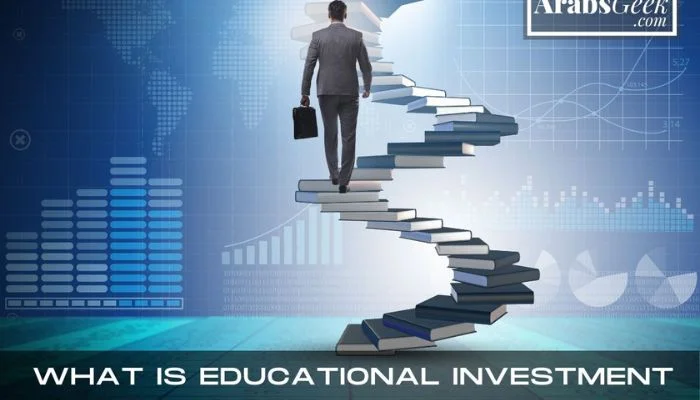Introduction | What Is Educational Investment
The Concept of Educational Investment
Educational investment refers to the allocation of resources, such as time, money, and effort, towards acquiring and enhancing knowledge, skills, and abilities. It encompasses a wide range of activities, from formal schooling and professional development to informal learning experiences.
Table of Contents
Importance of Investing in Education | What Is Educational Investment
Investing in education is crucial for both personal and societal growth. It can lead to increased earnings, improved job opportunities, and a higher quality of life for individuals. At the same time, it contributes to economic growth, social cohesion, and overall well-being in communities.
For any business enquiry, you can contact us at ArabsGeek.com
For more of such financial articles, Consider visiting our sister website at EntrepreneursPilot.com
Types of Educational Investment
Individual Investment
Personal Academic Pursuits | What Is Educational Investment
This includes investing in one’s own education through attending school, college, or university. It can also involve pursuing additional degrees, certifications, or specialized training to enhance career prospects and personal growth.
Professional Development
Individuals can invest in their education by participating in workshops, conferences, or online courses related to their field. This helps to stay current with industry trends and expand professional networks.
Family Investment | What Is Educational Investment
Private Schooling
Families may choose to invest in private education for their children, which often provides smaller class sizes, specialized curricula, and additional resources compared to public schools.
Extracurricular Activities | What Is Educational Investment
Enrolling children in extracurricular activities, such as sports, arts, or clubs, can provide valuable learning experiences and foster personal development.
Government Investment
Public Education Funding
Governments allocate resources to support public education systems, including primary, secondary, and higher education institutions. This investment helps to ensure access to quality education for all citizens.
Financial Aid Programs | What Is Educational Investment
Governments may also offer financial aid programs, such as scholarships, grants, or loans, to help individuals cover the costs of education and encourage participation in higher learning.
Factors to Consider in Educational Investment
Costs and Affordability
The financial aspect of educational investment is a significant factor to consider. Tuition, fees, books, and living expenses can add up, making it essential to plan and budget for these costs.
Return on Investment
When investing in education, it’s crucial to consider the potential return on investment (ROI), such as increased earnings, job opportunities, or personal satisfaction.
Quality of Education | What Is Educational Investment
The quality of education is vital in ensuring that the investment leads to meaningful outcomes. This can be assessed through factors like accreditation, faculty qualifications, and available resources.
Long-Term Goals and Objectives
Aligning educational investments with personal and professional goals can help maximize the benefits and ensure that resources are allocated effectively.
The Impact of Educational Investment
Economic Benefits
Investing in education can lead to higher income levels, increased productivity, and overall economic growth. A well-educated workforce is more likely to drive innovation and contribute to a nation’s competitiveness.
Social Benefits | What Is Educational Investment
Education is linked to numerous social benefits, such as improved health, reduced crime rates, and increased civic participation. It promotes social cohesion and helps to create more equitable societies.
Personal Benefits
On a personal level, educational investment can lead to improved self-esteem, critical thinking skills, and a broader understanding of the world. It can also provide a sense of accomplishment and purpose.
Challenges in Educational Investment
Limited Resources | What Is Educational Investment
Resource constraints, both at the individual and governmental levels, can pose challenges in investing in education. Budget cuts and economic downturns may lead to reduced funding for public education systems.
Inequality in Educational Opportunities
Disparities in access to quality education, particularly for marginalized groups, can limit the benefits of educational investment and perpetuate cycles of poverty and disadvantage.
Changing Educational Landscape
Rapid advancements in technology and shifting labor market demands require constant adaptation in educational investments to ensure that skills and knowledge remain relevant and up-to-date.
Strategies for Effective Educational Investment
Prioritizing Education Funding
Governments, families, and individuals should prioritize education funding to ensure that resources are allocated effectively and directed towards high-quality learning experiences.
Promoting Access to Quality Education
Efforts should be made to promote access to quality education for all, addressing disparities in educational opportunities and resources among different socioeconomic groups.
Encouraging Lifelong Learning
A focus on lifelong learning can help individuals adapt to the changing educational landscape, ensuring that they continue to acquire relevant skills and knowledge throughout their lives.
Conclusion | What Is Educational Investment
Educational investment is a vital aspect of personal and societal development, encompassing various types of investments, such as individual academic pursuits, family investments, and government support. Careful consideration of factors like costs, ROI, and long-term goals is essential to make the most of these investments. By prioritizing education funding, promoting access to quality education, and encouraging lifelong learning, we can maximize the benefits of educational investment and create a brighter future for individuals and society as a whole.
Frequently Asked Questions (FAQs)
Q1: What is Educational Investment?
Educational investment refers to the allocation of resources, such as time, money, and effort, towards acquiring and enhancing knowledge, skills, and abilities.
Q2: What are the Types of Educational Investment?
Types of educational investment include individual investment (personal academic pursuits and professional development), family investment (private schooling and extracurricular activities), and government investment (public education funding and financial aid programs).
Q3: What Factors should be considered in Educational Investment?
Factors to consider include costs and affordability, return on investment, quality of education, and alignment with long-term goals and objectives.
Q4: What are the Benefits of Educational Investment?
The benefits of educational investment include economic benefits (higher income levels, increased productivity, and overall economic growth), social benefits (improved health, reduced crime rates, and increased civic participation), and personal benefits (improved self-esteem, critical thinking skills, and a broader understanding of the world).
Q5: What are some Strategies for Effective Educational Investment?
Strategies for effective educational investment include prioritizing education funding, promoting access to quality education, and encouraging lifelong learning.











